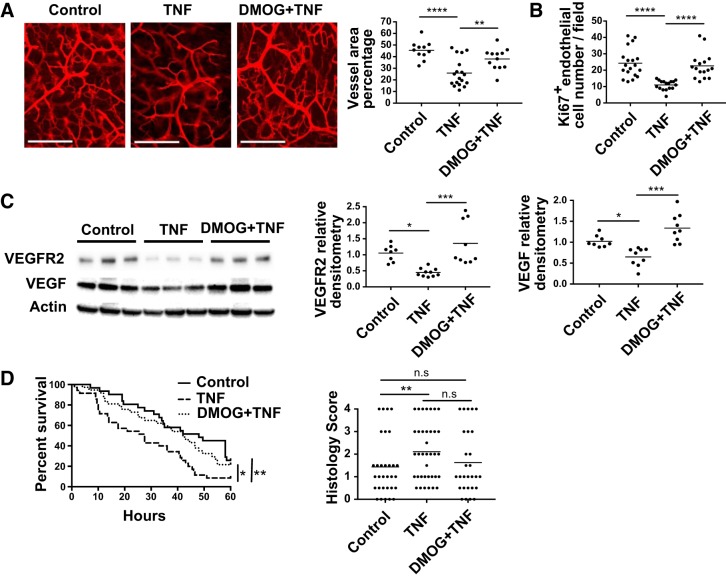Fig. 6.
TNF decreases small intestinal microvasculature density, endothelial cell proliferation, and VEGF and VEGF receptor 2 (VEGFR2) protein expression in vivo, which are prevented by dimethyloxalylglycine (DMOG) administration. DMOG attenuates TNF detrimental effects on intestinal injury and mortality in experimental necrotizing enterocolitis (NEC). Pups were administered DMOG or vehicle only (control) intraperitoneally 16 h before intraperitoneal injection of TNF on day 1. A: dye was injected and intestinal tissues were collected 24 h later. Small intestinal submucosal microvasculature images (left) and quantification of microvascular density (right) are shown. Data represent 3 independent experiments from 3 litters (n = 11: control, n = 18: TNF, and n = 12: DMOG+TNF group). Data were analyzed by one-way ANOVA. Scale bar = 200 μm. Intestinal tissues were collected at day 2 (24 h after TNF treatment) and examined by immunofluorescence for endothelial cell proliferation (Ki-67+ endomucin+ cells) (B) or Western blot analysis for VEGF and VEGFR2 expression (C). Data represent 3 separated experiments from 3 litters and were analyzed by one-way ANOVA. D: pups were injected intraperitoneally with TNF or vehicle control and submitted 2 hr later to the NEC model. Animal survival (left) and tissue injury severity score (right) were assessed. Data represent three independent experiments (n = 38: TNF group, n = 31: DMOG+TNF group, n = 32: control group. Log-rank test was used for survival curve and χ2 test for histological score analysis. *P < 0.05, **P < 0.01, ***P < 0.001, ****P < 0.0001. n.s., not significant.

